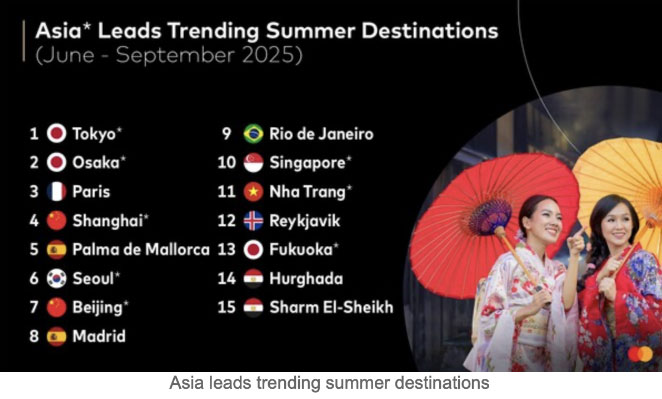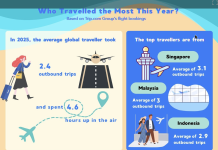SINGAPORE, 21 MAY 2025: Asia is home to eight of the world’s top 15 trending summer travel destinations, according to Travel Trends 2025, the annual Mastercard Economics Institute (MEI) report on consumer spending in the travel economy.
While exchange rates and geopolitical dynamics can influence behaviour, the report highlights that passions and purpose-driven motivations remain strong drivers shaping the travel industry. The report uncovers what is shaping travel choices today by drawing on a unique analysis of aggregated and anonymised transaction data and third-party data sources.

Highlights from the Asia-Pacific region: Japan leads the pack — with Vietnam’s Nha Trang rising fast.
Tokyo and Osaka are the world’s first and second top trending destinations for summer travel (June-September 2025), with the two most significant increases in tourism demand relative to previous levels.
In 2024, Japan’s capital city climbed from the number two spot held in 2023 to lead global travel demand heading into the peak summer season, reflecting its continued appeal. Meanwhile, Nha Trang in
Vietnam made a surprise entry into the list, climbing in popularity thanks to its beautiful beaches, enviable coastline and vibrant nightlife.
China and India are still Asia’s travel titans. The Chinese Mainland remained the world’s largest outbound travel market in 2024. Chinese travellers increasingly prioritise value and visa-friendly destinations, including Japan, Malaysia, and Singapore. Interest in Central Asian destinations such as Kazakhstan, Uzbekistan, and Kyrgyzstan is also increasing.
India again posted the country’s highest number of outbound travellers on record in 2024. Indian tourists are exploring a broad mix of destinations—the top three being Abu Dhabi, Hanoi, and Bali—with growth supported by expanded direct flight connections and a rapidly growing middle class eager to travel. The two markets continue to play an outsized role in shaping global travel flows.
Experiences over itineraries: Across Asia-Pacific, travellers are prioritising dining, nature, and wellness as key motivators for travel, seeking meaningful moments over traditional sightseeing. Destinations like Gianyar in Bali, Indonesia, known for its iconic Babi Guling spit-roasted pork, and Queenstown in New Zealand — where restaurants welcomed tourists from 44 countries in 2024 — stand out as globalised culinary hotspots.
Sports fandom fuels travel: The rise of sports tourism continues, with major events like the Australian Open tennis tournament and the Baseball World Series in Los Angeles drawing significant international spending. Shohei Ohtani’s World Series debut saw spending by Japanese visitors surge by 91%, six times the broader cross-border boost, highlighting how sporting events are proving to be powerful travel catalysts for fans.
Mastercard chief economist Asia Pacific David Mann said: “The Asia-Pacific region continues to set the pace for global travel, with buzzing destinations like Tokyo, Shanghai, Seoul, and Singapore capturing the imagination of travellers worldwide. Even as economic uncertainty persists, travel remains a bright spot — driven by people seeking meaningful, value-driven experiences. From exchange rates to regional accessibility, travellers are making smarter, more intentional choices about where they go and why, with a clear shift toward more personal, purposeful journeys.”
Travellers from Asia tend to be more sensitive to exchange rate shifts. A weaker yen throughout much of 2024 significantly boosted Japan’s inbound tourism, making the country a compelling destination for visitors searching for value. Notably, a 1% depreciation of the JPY against the RMB is associated with a 1.5% increase in tourists from the Chinese Mainland. However, visitors from New Zealand and the US rose only around 0.2% in response to the same degree of depreciation relative to their currencies.
In 2024, Singaporean visitors to Japan hit record highs — thanks to a 40% rise in the Singapore Dollar (SGD) vs. Japanese Yen (JPY), even as airfare and hotels got pricier.
Turning to the US, MEI’s analysis shows that tourists from India, Singapore, South Korea, and Taiwan are susceptible to exchange rate fluctuations after accounting for other factors. Specifically, a 1% depreciation of the United States Dollar (USD) against their local currencies corresponds to an approximate 0.6–0.8% increase in the number of tourists travelling to the US. These findings, consistent with our earlier analysis of tourism to Japan, suggest that these travellers are more responsive to exchange rate movements when selecting outbound destinations.
The shifting sands of business travel: Corporates today limit global travel in favour of regional trips. And while people take fewer business trips overall, the average duration is more prolonged, suggesting efforts to stretch travel budgets. For example, US-based travellers’ trips to Asia-Pacific increased from 8.8 days[3] to 10.2 days.
Travel fraud demands a safer, more intelligent travel ecosystem. According to MEI, fraud in popular tourist destinations spikes up to 28% during peak seasons. Common scams include inflated charges in restaurants and taxis, fake tour companies, and fraudulent property listings. To combat these, Mastercard employs advanced fraud prevention technologies, including digital wallets and AI-driven systems, to protect travellers. This ensures that travellers can focus on their journeys without worrying about security threats.
View the “Travel Trends 2025: Purpose-driven Journeys” report here and other insights from MEI, here.






